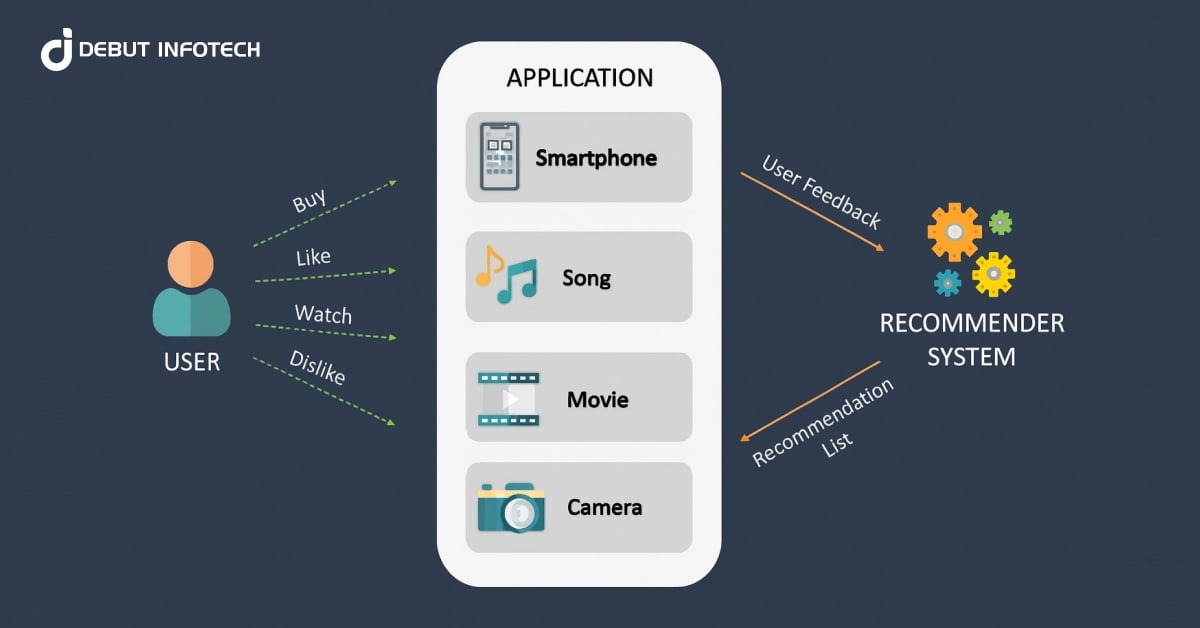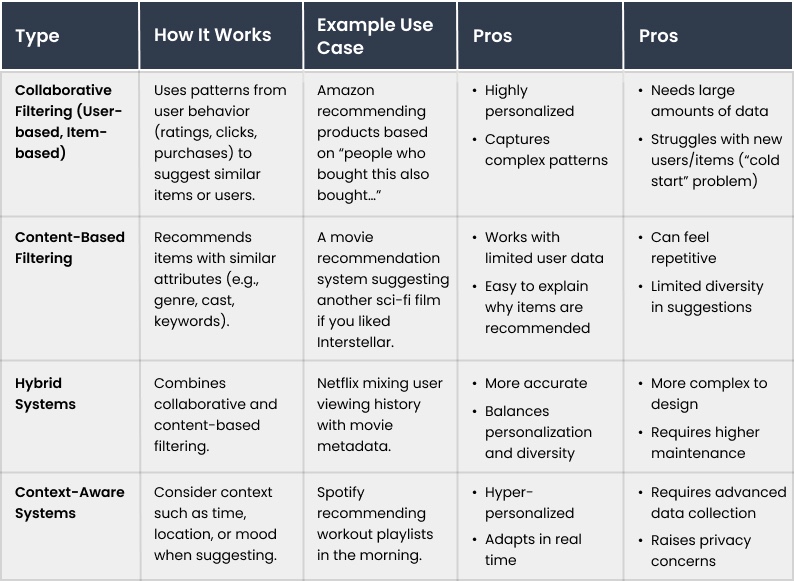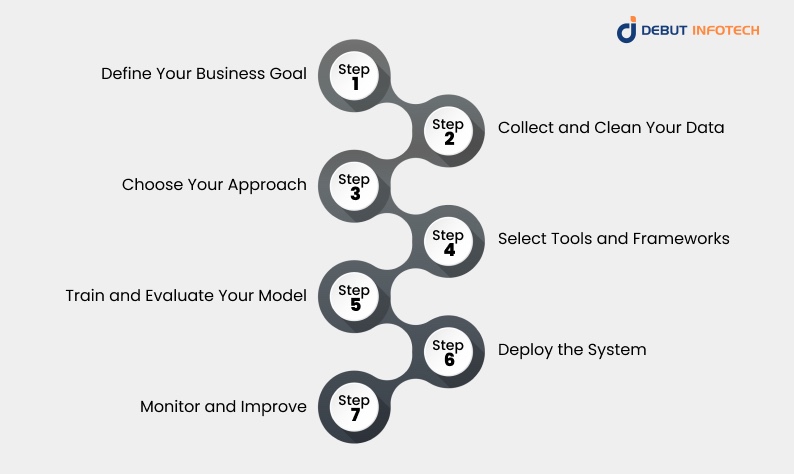Table of Contents
Home / Blog /
Step-by-Step Guide to Building a Smart Recommendation System
October 6, 2025

October 6, 2025
Remember the last movie you binge watched on Netflix, the item you ordered on Amazon, or the playlist on Spotify that offered a personalized experience like it was created specifically to resonate with you? Those recommendations were not accidental. A smart system was working behind the scenes to examine your habits and figure out what you were likely to like next. That is what a recommendation system accomplishes, it transforms data into an individual experience that is natural, useful, and almost effortless.
Ultimately, the essence of a recommendation system is that it is a smart system that processes data such as your clicks, searches, purchases or even the length of time you watch a video and recommends something that you will probably like. It is almost like having a digital assistant that understands your taste and can find you what you need without scrolling through a list.
In this guide, we’ll walk you through how to build a recommendation system step by step. You will get to know the pitfalls that developers commonly encounter, tools that make the process easier and the best practices to observe in case you wish your system to be not only accurate but also easy to use. At the end, you will not only know the mechanics but also learn how these systems can revolutionize user interaction in practical use cases.
Let’s begin!
What Is a Recommendation System?
A recommendation system is simply a smarter assistant that can assist users in finding what they are most likely to enjoy, be it a product, movie or a playlist. Rather than letting individuals scroll endlessly, it applies artificial intelligence technology to learn through past behaviors and present ideas that seem nearly customized.
This works in two major ways. Personalized recommendations adapt to individual behavior like Netflix suggesting shows under “Because you watched…” or Spotify curating a Discover Weekly playlist based on your listening habits. Conversely, non-personalized are those that apply to all people, including the list of Best Sellers on the Amazon website or the Trending section on YouTube, where the only way to appear is to be popular.
You likely got a feel of the strength of these systems yourself. Amazon guides shoppers with prompts like “Customers who bought this also bought…,” while Netflix shapes much of your viewing journey by learning from what you’ve already watched. Even YouTube silently directs your experience, recommending videos to play at once or dropping customized selections on your homepage.
The impact is enormous. Recent research indicates that AI-driven recommendations already make up 35% of Amazon’s overall sales and affect up to 80% of what users watch on Netflix. That kind of reach shows just how pivotal these systems are in making choices easier and more relevant, without us even realizing it.
Turn browsing into buying with a powerful recommendation engine.
We build AI systems that personalize user journeys and skyrocket engagement.
Key Types of Recommendation Systems
A good way to learn how to build a recommendation system is to know the various kinds of recommendation systems that run platforms such as Netflix, Amazon and Spotify. All methods have some advantages, and the most suitable decision usually depends on your objectives, data and audience. Let’s break down the main ones:

1. Collaborative Filtering
This is one of the most widespread approaches. Collaborative filtering examines user behavior such as ratings, clicks or purchase history to determine patterns.
- User-based filtering: Identifies individuals with similar preferences and suggests what they enjoyed. Examples: When you and another user watch many Marvel movies, the system can recommend the new DC movie to both of you.
- Item-based filtering: Emphasizes on similarities among items. Assuming that lots of users, who were watching Inception, also enjoyed Interstellar, the system will probably suggest it to you.
It is potent, but lots of user interaction data is required to do well.
2. Content-Based Filtering
Rather than examining the behavior of a user, this approach examines the characteristics of an item. As one of the examples, an algorithm in a movie recommendation system could use a similar genre, cast or director of a movie you enjoyed to make a recommendation.
This is an excellent method when you do not have much data on the user (e.g. with new users), but it may be restrictive as it has the propensity to remain within a small range of similar items.
3. Hybrid Systems
The vast majority of large platforms do not focus on a single approach. An example of this hybrid recommendation system design is one adopted by Netflix, which comprises both collaborative and content-based filtering. This balance assists in making more precise and varied recommendations.
4. Context-Aware Systems
These systems take it one step further by considering context, i.e., time of the day, where you are, or even what you did recently.. An example of this hybrid recommendation system design is one adopted by Netflix, which comprises both collaborative and content-based filtering. To illustrate, a music application can suggest music playlists that are energetic in the morning and more relaxing at night.
Read More – Taking personalization to the Next Level with AI-based Recommendation Systems
Context-aware systems are gaining popularity, as personalization extends beyond what you like, to what you need at a moment in time.
Step-by-Step Guide to Building a Recommendation System
So, how do you actually build a recommendation system that delivers real value? Let’s walk through it step by step. Regardless of whether you are creating a simple movie recommendation system or an advanced personalized recommendation engine, the process is based on the same basis.

1. Define Your Business Goal
Start with clarity. Are you aiming at retaining more customers, selling more, or retaining users on longer terms? An example is that Netflix optimizes recommendations to ensure that individuals continue to watch, whereas Amazon aims at making more sales. With a goal in mind, it is more straightforward to create a system that is actually beneficial to your business.
2. Collect and Clean Your Data
Your system is only as smart as the data that you feed it. Collect information such as purchase history, user ratings, click behavior, and profile information. When collected, clean it up, get rid of duplicates, missing values, and mismatched formats. The basis of accurate recommendations is clean data.
3. Choose Your Approach
Next, choose how your recommendation engine will operate. Collaborative filtering makes predictions about what a user may like based on the behavior of other users. Content-based filtering examines the characteristics of items, including genre, category, or price. Hybrid models combine the two methods to be more accurate and customizable. Collaborative filtering is usually the simplest place to begin with, particularly when new to this.
4. Select Tools and Frameworks
You do not have to reinvent the wheel. Python is commonly used by developers in a flexible way, while deep learning relies on TensorFlow or PyTorch and more conventional methods of machine learning on Scikit-Learn. The decision you make should be based on the expertise of your team and the magnitude of the project.
5. Train and Evaluate Your Model
After your model is in place then it is time to test it. Measure accuracy with track measures such as precision and recall, predictive quality with RMSE (Root Mean Square Error), and the utility of top recommendations with MAP@K. These assessments will make sure that your engine is providing results that count, rather than empty ideas.
6. Deploy the System
After training, the next step is deployment. With cloud computing systems like AWS, Google Cloud, or Azure, it is simple to start and scale your recommendation engine. At this point you will also add it to your app or web site so that users can start viewing personalized recommendations in real time.
7. Monitor and Improve
Building of the system is just the start. In order to remain efficient, your recommendation engine requires continuous maintenance. Conduct A/B tests to identify the best recommendation strategy, seek user feedback to optimize personalization, and re-train your model on new data to keep it current and interesting.
Related Read: Understanding Recommendation Systems in Machine Learning.
Challenges & Limitations of Building a Recommendation System
Recommendation system development may be exciting, but it does not come without challenges. Although these systems drive some of the most successful applications in our daily lives, they also possess certain challenges that all teams must consider before getting into it.
1. The Cold Start Problem
The cold start problem is one of the largest challenges. This occurs when you have new users or new items with very minimal or no historical data. In the absence of data, the system can hardly produce meaningful recommendations. To illustrate, once a new user registers on a streaming platform, the algorithm does not know their preferences yet. One way companies address this is by requesting users to rate a small number of items initially or by demographic-based recommendations as a baseline.
2. Data Sparsity
Recommendation systems are data-driven, however in most situations there is a lack of interaction between users and items. Think about a shopping site that has thousands of items and few reviews or purchases per item. The lack of data complicates the detection of powerful trends by the system, which may result in less precise recommendations. This is where methods such as matrix factorization or hybrid methods fit in to fill in the gaps.
3. Dynamic User Preferences
Interests of people vary with time. Something that a user liked last month may not be important today. A recommendation system must be able to respond fast to such changing preferences. As an illustration, a customer who has recently purchased baby items may not require constant baby-related recommendations in two years. This can be solved by continuous learning and adaptive AI models, though it remains a difficult issue to solve.
4. Interpretability & Transparency
Many recommendation algorithms, especially deep learning–based ones, act like “black boxes.” They generate results without clearly showing why. To users, this lack of transparency can be frustrating or even manipulative. Recommendations that are easily explainable such as, “We suggested this movie because you watched X”, goes a long way in building user confidence.
Case Studies & Real-World Applications
Recommendation systems work best when they do more than just crunch numbers, they make life easier for real users. That’s exactly what we aimed to do when we built a recommendation system for Friendspire, helping people discover movies, books, podcasts, and TV shows they genuinely enjoy.
The Challenge
The entertainment industry is a very saturated industry with over 400 streaming services seeking to gain attention. Users tend to be overwhelmed with unlimited choices and doubt fake reviews. The founders of Friendspire, Markus Straarup and Morten Schroeder, wanted to make a change. Their idea was to have an easy-to-use personalized recommendation platform that allowed users to find movies, books, podcasts, and TV shows they like without the noise.
The Solution
Markus and Morten required more than an idea to convert this dream into reality. They had to find the appropriate technology partner that has knowledge on AI-based recommendation systems. Working together, we built Friendspire, an app that uses collaborative filtering and smart suggestions to give each user a unique experience.
Key features included:
- Personalized recommendations tailored to user taste.
- Genuine, community-driven reviews that cut through fake ratings.
- The ability to save, track, and share favorites with friends and family.
From Proof of Concept to Market Traction
Similar to other great products, Friendspire began small. We developed a Proof of Concept (PoC) to verify feasibility and adoption by users. The reaction was immense and the PoC quickly took off and within a few months, the app was scaled into a fully functioning platform running on iOS and Android.
This achievement underscores the importance of identifying the appropriate tech team. When you hire AI developers with experience in recommendation systems, you’re not just building code, you’re building confidence that your idea can scale.
The Results
Friendspire did not merely launch, it prospered. The platform has raised $300K in seed funds in 2020 and $260K in 2021, which demonstrates investor confidence in the product and the model of recommendations used to create it. Beyond funding, the app built a loyal community, rewarding developers weekly for their contributions and constantly improving the user experience.
Future Trends in Recommendation Systems
Recommendation systems are developing rapidly, and the future will be even more promising. Rather than just showing the statement “people also watched” or “customers also bought,” tomorrow’s platforms will feel almost tailor-made for each user.
Generative AI-Driven Personalization
Generative AI is taking the notion of personalization to an entirely new dimension. Rather than simply using past information, a customized recommendation engine based on GenAI can produce recommendations in real time, whether it be in composing a playlist that matches your mood, or creating a workout plan, or suggesting study paths based on your desired activities.
Context-Aware and Multimodal Systems
The next generation systems are not only going to focus on what you click. They will take into account the surroundings in which you are, such as your location, device or even the time of the day. The inclusion of multimodals (voice, video, IoT devices) makes recommendations get more intuitive. Think of a smart fridge that can recommend recipes based on what you have and your TV that can recommend shows after just asking it to.
Essentially, the subsequent generation of recommendation systems will no longer feel like algorithms but rather smart assistants capable of predicting what you desire before you even speak with it.
Want a recommendation system that feels like magic?
Let’s craft your custom AI solution for unmatched customer engagement.
Endnote
Smarter apps now rely on recommendation systems to make user experience more personalized, engaging and impactful. Whether it is shopping sites or media apps, they assist users in locating what they require and propel actual business expansion.
The most intelligent course of action is to go small, start testing, and grow with confidence. This is where the right partner comes in.
As a leading custom software development company with expertise in ai development, Debut Infotech has empowered brands across industries to build recommendation systems that truly deliver. By combining advanced AI tools with tailored software solutions, we help turn personalization into a competitive advantage.
Let’s build the smarter experiences your users deserve.
Frequently Asked Questions (FAQs)
A. A recommendation system is a type of artificial intelligence (AI) algorithm.
It often uses machine learning techniques to analyze data.
By processing large amounts of information (Big Data), it can suggest products, services, or content that a user is likely to enjoy.
A. A recommendation system learns from user interactions. These interactions create implicit feedback, which helps the system understand preferences.
– Some common examples include:
– Ratings on products or content
– Browsing history
– Clicks and link activity
– Interactions with content (like watching a video or liking a post)
– Purchase history
– Search history
All of these data points work together to help the system suggest more relevant and personalized options.
A. The main goal of a recommendation system is simple: help users find what they’ll enjoy or need most. It does this by filtering through huge amounts of information and showing only the most relevant options.
For example, on a music streaming app, the system might suggest new songs that match your past listening habits.
Talk With Our Expert
Our Latest Insights
USA
2102 Linden LN, Palatine, IL 60067
+1-708-515-4004
info@debutinfotech.com
UK
Debut Infotech Pvt Ltd
7 Pound Close, Yarnton, Oxfordshire, OX51QG
+44-770-304-0079
info@debutinfotech.com
Canada
Debut Infotech Pvt Ltd
326 Parkvale Drive, Kitchener, ON N2R1Y7
+1-708-515-4004
info@debutinfotech.com
INDIA
Debut Infotech Pvt Ltd
Sector 101-A, Plot No: I-42, IT City Rd, JLPL Industrial Area, Mohali, PB 140306
9888402396
info@debutinfotech.com




Leave a Comment